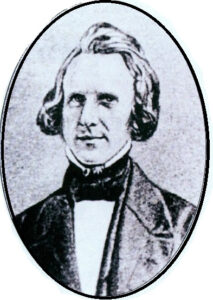
On October 27, 1797 Mr. Pitney was born in Mendham New Jersey where his family resided for many centuries. He grew up to study medicine at The University of Columbia, later going on to practice for two years in the Staten Island hospital. Dr. Pitney soon returned to New Jersey to practice medicine in his hometown, but his practice didn’t seem to be enough for him. Dr. Pitney had some other ideas…
In May of 1820 Jonathan Pitney road horseback one hundred miles from home to the small town of Absecon ,where he became, according to local historians, “the most influential physician of the county”. Dr. Pitney extolled the restorative properties of the sea air and salt water of Absecon Island through his medical practices to the few people living in English Creek and Port Republic. He was convinced that with Absecon’s perfect climate and accessible salt water, it would make the perfect health resort.
Mr. Pitney along with Samuel Richards, a glass maker of the town, had the idea of train transportation to run through Absecon. He saw Atlantic City and Absecon Island’s potential of being “ a city on the sea” but the limited transportation, beside horse and carriage, made it difficult for the city to be found and loved by many. Locals were weary of Dr. Pitney’s idea of the doctors talk and deemed his railroad to Absecon to be “the railroad to nowhere”. Unconcerned with the publics opinion, Jonathan was persistant in making Absecon a destination location. In September of 1852 a contract was awarded to Jonathon Pitney for the construction of a railroad between Delaware River and Absecon Island. Just a short two years later, July 4, 1854 the railroad to Absecon was completed and trains began to be operating fully. Just as Mr. Pitney promised, the railroad was a great success and is what stated Atlantic City to be a land boom. Thanks to Pitney’s efforts that Atlantic City’s tourism and industry could grow to eventually become the global resort destination that it is today.

Along with the building of railroad that led Atlantic City to fame, Dr. Jonathan Pitney was involved in many other aspects of the community. Around 1835 during his career as a doctor, Jonathan Pitney would often travel by horseback through the sand dunes of Absecon Island to visit his patients. This led him to witness many ship wrecks along the coast, especially at what is now known as the “Graveyard Inlet” . He started his plea to congress for a light house to be built. It was not until 1854 after the packet ship Powhatan sank off the coast of New Jersey in a storm killing about 311 people, did congress take notice to Pitney’s request. During the ship wreck some of the victims washed up to the shore of Atlantic City. Forty Five were buried in Absecon, and Fifty Four were buried at Smithville Methodist Church, a graveyard directly across from The Pitney House. After almost a decade of plea-ing, a Congressional grant of $35,000 for the construction of the Absecon Lighthouse in Atlantic City in 1857 was granted. The Absecon Lighthouse is still up and running today.
